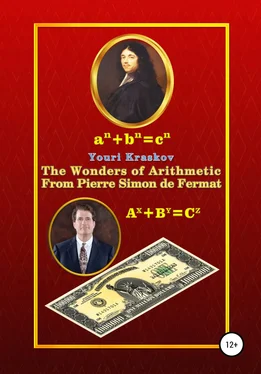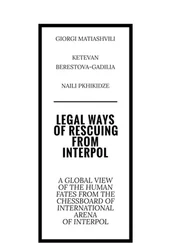In this case, identity (9) indicates that the same key formula is substituted into the transformed key formula (2) or that the equation (8) we obtained, is a key formula (2) in power n. But you can go the reverse way just give the identity (9) and then divide into factor the differences of powers and such a way you can obtain (8) without using the Fermat Binominal (7). But this way can be a trick to hide the understanding of the essence because when some identity falls from the sky, it may seem that there is nothing to object. However, if you memorize only this path, there is a risk of exposure in a misunderstanding of the essence because the question how to obtain this identity, may go unanswered.
Taking into account that c−a=b−2m the expression in square brackets of equation (8) can be transformed as follows: (c++b) n− (a++2m) n= с n-1− a n-1+ c n-2b− a n-22m+ c n-3b 2− a n-3(2m) 2+ … +b n-1− (2m) n-1; с n-1− a n-1= (с − a)(c++a) n-1; c n-2b − a n-22m = 2m(c n-2− a n-2) + c n-2(b − 2m) = (c − a)[2m(c++a) n-2+ c n-2]; c n-3b 2−a n-3(2m) 2= (2m) 2(c n-3− a n-3) + c n-3(b 2− 4m 2) = (c − a)[4m 2(c++a) n-3+ c n-3(b +2m)]; b n-1− (2m) n-1= (b − 2m)(b++2m) n-1= (c − a)(b++2m) n-1All differences of numbers except the first and last, can be set in general form: c xb y− a x(2m) y=(2m) y(c x− a x) + c x[b y− (2m) y] = (c − a)(c++a) x(2m) y+ (b − 2m)(b++2m) yc x= (c − a)[(c++a) x(2m) y+ (b++2m) yc x] And from here it is already become clear how the number (c − a) is take out of brackets. Similarly, you can take out of brackets the factor a + b = c + 2m. But this is possible only for odd powers n. In this case, equation (10) will have the form A iB iC iD i= (2m) n, where A i= c – b = a − 2m; B i= c – a = b − 2m; C i= a + b = c + 2m; D i– polynomial of power n − 3 [30].
Equation (10) can exist only if (1) holds i.e. {a n+b n−c n}=0 therefore, any option with no solutions leads to the disappearance of this ghost equation. And in particular, there is no “refutation” that it is wrong to seek a solution for any combination of factors, since A iB i=2m 2may contradict E i=2 n-1m n-2, when equating E ito an integer does not always give integer solutions because a polynomial of power n−2 (remaining after take out the factor c−a) in this case may not consist only of integers. However, this argument does not refute the conclusion made, but rather strengthens it with another contradiction because E iconsists of the same numbers (a, b, c, m) as A i, B iwhere there can be only integers.
In this proof, it was quite logical to indicate such a combination of factors in equation (10), from which the Pythagoras’ numbers follow. However, there are many other possibilities to get the same conclusion from this equation. For example, in [30] a whole ten different options are given and if desired, you can find even more. It is easy to show that Fermat's equation (1) is also impossible for fractional rational numbers since in this case, they can be led to a common denominator, which can then be reduced. Then we get the case of solving the Fermat equation in integers, but it has already been proven that this is impossible. In this proof of the FLT new discoveries are used, which are not known to current science: there are the key formula (2), a new way to solve the Pythagoras’ equation (4), (5), (6), and the Fermat Binomial formula (7) … yes of course, else also magic numbers from Pt. 4.3!!!





![Theresa Cheung - The Dream Dictionary from A to Z [Revised edition] - The Ultimate A–Z to Interpret the Secrets of Your Dreams](/books/692092/theresa-cheung-the-dream-dictionary-from-a-to-z-r-thumb.webp)






